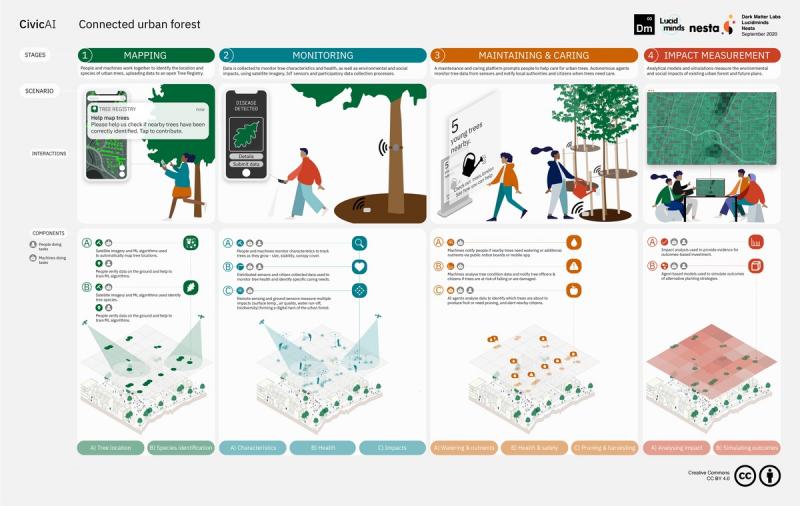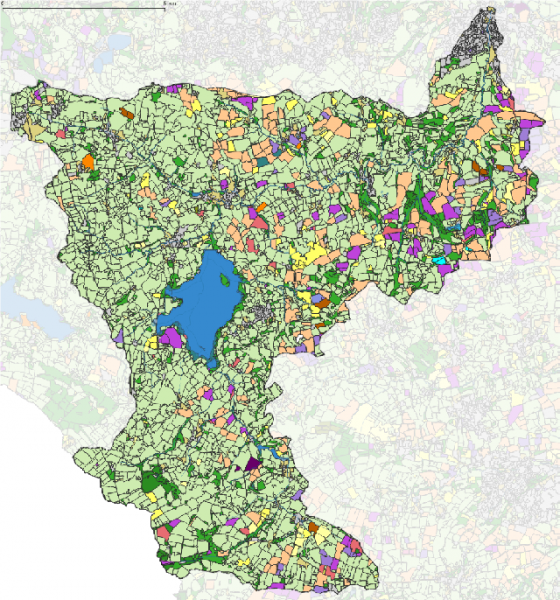Mary Stevens27 Oct 2020
Two years ago we set ourselves what seemed like an unusual challenge for an environmental NGO. We started to explore the world of Augmented and Artificial Intelligence and to ask whether its benefits could be harnessed to deliver a fairer society in a healthy environment.
When we hosted a roundtable lunch at CogX – one of the only two NGOs present on that occasion (the other was Mind, the mental health charity) – we felt distinctly uncomfortable. For every passing mention of our planetary crisis there were a hundred widgets to boost your sales and grow your crypto-currency investments. I wrote more about this here.
But the world around us has moved fast. The first item on every CogX newsletter is now a ‘Fridays for the Future’ feature. Meanwhile the clever people at Dark Matter Labs have kept pursuing the same research question – how can AI and collective intelligence enable new forms of community response to the climate crisis? – and, with support from Nesta, have launched the Civic AI toolkit.
So it’s a real privilege to have been invited back to share our reflections at the online launch event. I was able to respond to the ideas in the toolkit and to raise some outstanding issues.
What is the Civic AI toolkit?
The Civic AI toolkit builds on a set of six challenges for community groups. Some resonate strongly with our experience at Friends of the Earth, such as ‘measuring impact’ and ‘conducting maintenance’ which have been a key focus in our Postcode Gardener project from the start. Some are more far-reaching, like the need to ‘expand perspectives’ and incorporate non-human or future generations’ perspectives into our collective understanding.
The toolkit takes these challenges and develops a set of three blueprints where the researchers think there is the most potential for prototyping the technology in the next five to seven years. These are:
The connected urban forest
Helping to measure the holistic benefits of urban trees (and build a viable financial model for urban greening as a consequence).
Collective climate action
Addressing the challenge of local community organising – and helping residents to maximise the impact of their action.
Participatory energy
Optimising the set-up and operation of community energy initiatives to democratise access to localised renewable systems.
All of these are areas where Friends of the Earth has a significant interest, from our community electric vehicle project to our growing network of climate action groups. We’ve incorporated machine learning into our other workstreams, such as the Woodland Opportunity Map, for which Tim Richards trained an algorithm on satellite images to classify actual vegetation cover.
Where next?
We see the most potential is in measuring the cumulative impact of a wide range of small-scale local initiatives – the planters, the tree pits, the unmown verges – and then putting accurate, locally adapted real-time data in the hands of local activist-residents. Empowered by this, they can collectively make the most informed decisions about the needs of their local area in a rapidly changing context.
The connected urban forest blueprint could make the business case and therefore release the resource to allow us to scale the postcode gardener so that every postcode could have one.
I reflected on the need for accurate local data when thinking about my own neighbourhood. On my street in Bristol I am involved in a campaign to reduce the through-traffic, possibly through a road closure. Many residents are worried about traffic displacement. But what if we were able to use predictive AI to model a range of possible scenarios – building in the learning from pioneer areas and possibly even the changes in travel-to-work behaviour that have come about in the pandemic – to support a more informed and collaborative conversation (without the need for a lengthy and expensive modelling survey)?
How do we stay true to our values?
It is sometimes tempting to look for the technical solution and hope that AI will solve our problems. It could be seen as an easier option to avoid doing the hard graft and time commitment of building relationships on the ground. So it’s essential we continue to hold fast to our mission and keep addressing these three questions:
Where is the data?
Data is the engine that drives AI. If it doesn’t yet exist, can it be collected in a way that respects privacy and allows citizens to retain ownership over its use? As soon as we start thinking about micro-local action the smallness of the data becomes a big issue.
Is this solving a real problem?
‘Tech solutionism’ is always a trap. Just like ‘build an app’ is often pushed as the solution to everything, so AI applications might be the sledgehammers promoted to crack nuts. Do we really need a network of connected sensors to alert local people to when a tree needs harvesting or pruning? Most trees are already pretty good at signalling what they need – maybe we just need to learn to see better.
How does this free up our capacity to do the stuff that makes us uniquely human?
Getting more efficient at community organising might only be worth it if the spare time goes into the slow work of building strong relationships of trust with currently excluded groups, for example.
Would you like to work with us?
We are inspired by these blueprints and hope to find ways to continue to collaborate with Dark Matter and Nesta to explore their potential. Our unique contribution is our portfolio of existing projects and relationships, combined with our wider on-the-ground networks.
But getting complex civic-tech partnerships off the ground can be a challenge. If you have an idea for helping a small team with big ideas but limited resources move forward, please get in touch at [email protected].




